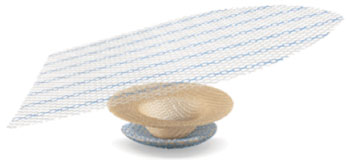Infrainguinal Plug Technique Safe for Hernia Repair
By HospiMedica International staff writers
Posted on 17 Dec 2014
A new study suggests that repair of femoral hernias (FHs) using an infrainguinal plug technique is a simple and effective procedure, without major postoperative events.Posted on 17 Dec 2014
Researchers at West China Hospital of Sichuan University (Chengdu, China) conducted a study of the UltraPro Plug (UPP) hernia repair device. The study included a total of 121 patients (105 females, mean age 57.6 years) who underwent a total of 125 elective FH repairs with the UPP between March 2009 and March 2013. Median follow-up was 26 months, and the total follow-up rate was 91%. The researchers assessed demographics, surgical information, and outcomes.

Image: The UltraPro Plug hernia repair device (Photo courtesy of Ethicon).
The results showed that FHs occurred more often on the right (72) than the left (45), and in four patients the hernias were bilateral. Mean duration of hernia surgery was 14.7 minutes, and 91% of patients were discharged within 24 hours. The mean time to complete return to daily activities was 7.4 days, and no mortality or major complications occurred during the perioperative period. No recurrence or chronic mesh infection was noted. Postoperative chronic pain in two patients, sensory loss in one patient, and foreign body sensation in three patients were found in the follow-up. The study was published in the December 2014 issue of the Journal of Surgical Research.
“The infrainguinal plug technique for femoral hernia has gained popularity for its feasibility, simplicity, and encouraging rate of success, but materials and structures of traditional mesh plugs may cause postoperative discomfort, plug migration, and even recurrence,” concluded lead author Yinghan Song, PhD, and colleagues of the department of gastrointestinal surgery. “This study suggests that repair of femoral hernias with UPP through an infrainguinal approach is a simple and effective procedure without major postoperative events.”
The UPP device, a product of Ethicon (Somerville, NJ, USA), is a partially absorbable plug-and-patch device with a design that provides stability in the defect to minimize the risk of migration. The sterile, thermoformed plug is composed of a non-absorbable mesh and manufactured using three dimensional (3D) warp knitting technology. The non-absorbable part is made from polypropylene monofilament fibers, while the absorbable mesh made of poliglecaprone 25 monofilament fibers; both parts are connected by poliglecaprone 25 monofilament fibers.
Related Links:
West China Hospital of Sichuan University
Ethicon














